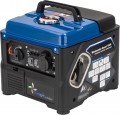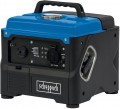Engine size
The working volume of the engine in a gasoline or diesel generator (see "Fuel"). Theoretically, more volume usually means more power, but in fact, everything is not so clear. Firstly, the specific power strongly depends on the type of fuel, and in gasoline units, also on the type of internal combustion engine (see above). Secondly, similar engines of the same power can have different volumes, and there is a practical point here: with the same power, a larger engine consumes more fuel, but by itself it can cost less.
Power
The operating power of the engine installed in the generator. Traditionally stated in horsepower; 1 HP approximately equal to 735 watts.
First of all, the rated power of the generator directly depends on this indicator (see above): in principle, it cannot be higher than the engine power, moreover, part of the engine power is spent on heat, friction and other losses. And the smaller the difference between these capacities, the higher the efficiency of the generator and the more economical it is. However high efficiency affects the cost, but this difference can pay off with regular use due to fuel savings.
Fuel consumption (50% load)
Fuel consumption of a petrol or diesel generator when operating at half power, and for combined models when using petrol (see “Fuel”).
Fuel consumption usually increases with load. However, generator efficiency is not always linear - fuel consumption may vary disproportionately with different loads. In this case, the approximate amount of fuel consumed by the generator when operating at half power (50% of the rated power) is given. Knowing the fuel consumption and tank capacity, you can at least estimate how long one fill-up will last.
Protection level
The level of protection provided by the generator housing — namely, the degree of protection of the “hardware” from dust, moisture and foreign objects. It is designated by the IP standard with two numbers, one of which corresponds to protection against solid objects and dust, the second — from moisture, for example, IP24.
According to the level of dust protection (first digit) in modern generators, the following values \u200b\u200bare found:
2 — protection against objects with a diameter of more than 12.5 mm (fingers, etc.);
3 — from objects larger than 2.5 mm (most instruments);
4 — from objects more than 1 mm (almost all tools, most wires);
5 — dustproof (full protection against contact; dust can penetrate inside, but does not affect the operation of the device).
Water protection levels can be as follows:
1 — protection against vertically falling drops of water;
2 — from water drops with a deviation of up to 15 ° from the vertical axis of the device (rain);
3 — from water drops with a deviation of up to 60 ° from the vertical axis of the device (rain with wind);
4 — against splashes from any direction (rain with strong wind);
In general, for indoor use, this indicator does not play a key role, but on the street and in similar conditions (for example, at a construction site), you should make sure that the selected generator is sufficiently protected — or else take additional protection measures.
Noise level
The noise level produced by the generator when operating in normal mode. The less noise the unit makes, the more comfortable it is to use, the closer it can be placed to people, but the higher its price, all other things being equal.
It is also worth considering that generators with internal combustion engines are, in principle, quite noisy equipment. Thus, even the "quietest" units produce
< 70 dB - this is the volume of a conversation in tones from medium to high. Accordingly, it is recommended to install the device remotely from the place of use. At the same time, we note that the noise level is not directly related to the power: for example, among units of 80 dB and more, there are both heavy and relatively low-power models.
Sound level (7 m)
Sound pressure level in decibels at a distance of 7 m between the noise source and the ear of the equipment operator. Since people do not work in the immediate vicinity of the generator, the parameter will be useful for estimating the noise level at a distance. For example, current European Union regulations require that the sound power of generating sets with a power of more than 2 kW does not exceed 97 dB — at a distance of 7 m, the noise from the generator engine will correspond to a sound pressure of about 72 dB.

